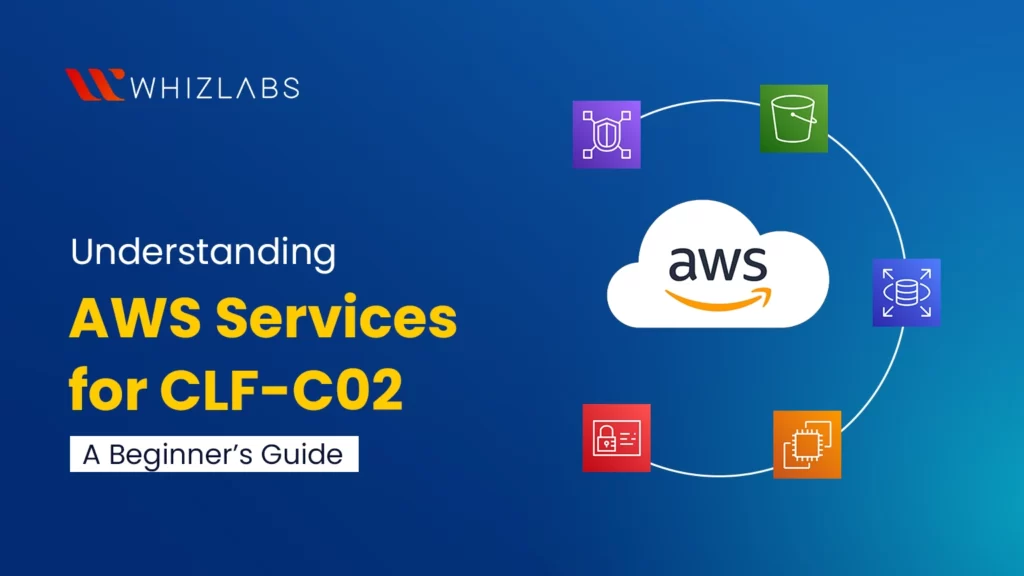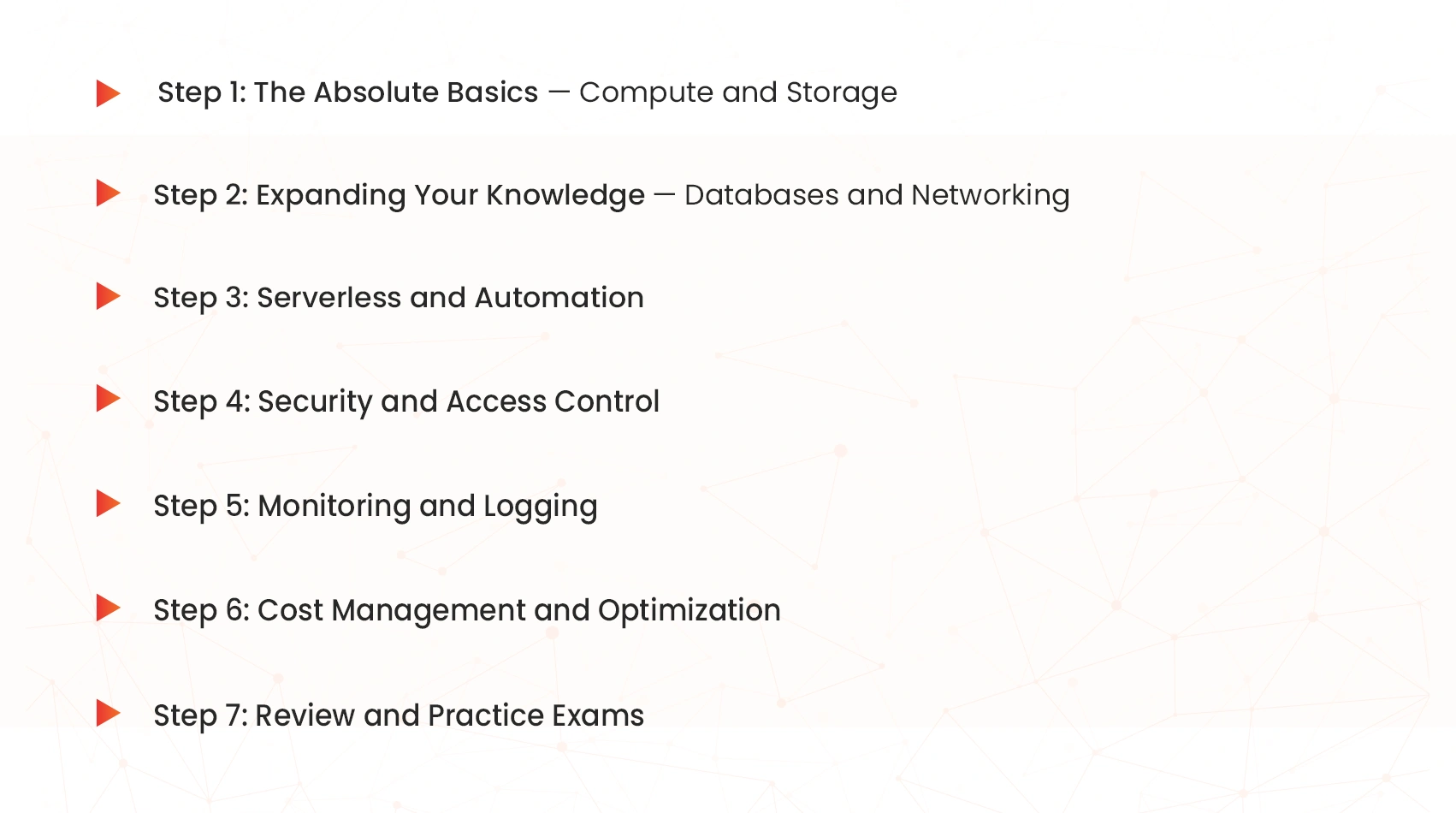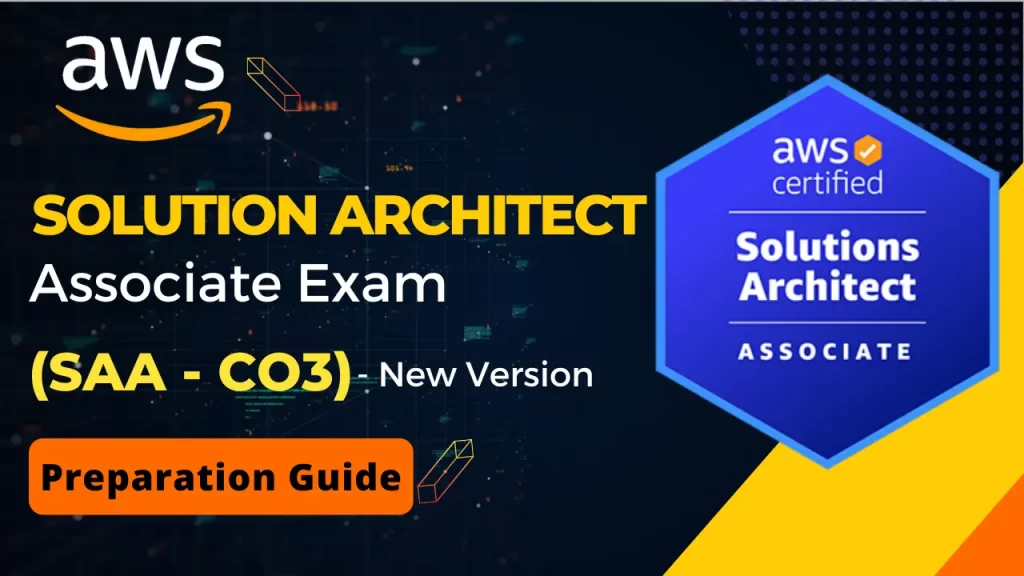In this blog, you will read about the crucial AWS services that an (aspiring) AWS Certified Cloud Practitioner should know. Do not miss out on the expert tips and tricks to prepare for your AWS CLF-C02. Read through to learn more about our learners’ experience, too!
What are the AWS Services Covered in the CLF-C02 Exam?
If you are in on-premises IT or cloud roles but are new to AWS, and require a primer before taking role-based AWS certifications. Or from a non-IT background and those who want to explore a career in the AWS Cloud, this cert’s syllabus helps you a lot. The understanding of key AWS services enhances credibility, marketability, and readiness for scenario-based exam questions.
Categorization of AWS services
Amazon EC2 (Compute)
Amazon EC2 provides scalable virtual servers for applications. As AWS CCP aspirants, knowing EC2’s instance types and use cases showcases compute expertise. This knowledge supports roles like cloud support engineer, where configuring and scaling EC2 instances ensures efficient, cost-effective solutions for clients.
Amazon S3 (Storage)
Amazon S3 provides object storage that is durable to manage data. Knowledge of S3 storage classes and use cases can improve data handling expertise. This is a critical expertise in cloud administrator roles to provide secure and cost-optimized storage solutions to business applications and analytics.
Amazon VPC (Networking)
Amazon VPC enables secure, isolated cloud networks. For CCP aspirants, mastering VPC’s subnets and security groups demonstrates networking proficiency. This skill is critical for cloud support or junior architect roles, where designing secure, scalable network architectures ensures robust application deployment and hybrid cloud connectivity.
Identity and Access Management (Security)
IAM is used to manage secure access to AWS resources. Security knowledge is developed through knowledge of IAM policies, roles, and MFA in CCP aspirants. This is the kind of knowledge needed in cloud security analyst job positions, and it makes you a certified expert in ensuring compliance and securing data in cloud computing environments, making you a trusted expert in cloud computing security.
AWS Global Infrastructure and Deployment Models
For CCP aspirants, knowing Regions, Availability Zones, and Edge Locations supports designing resilient, global applications. This expertise aids cloud consultant roles, where recommending multi-region setups ensures high availability and low latency, enhancing client trust and project scalability.
Billing, Pricing, and AWS Support Plans (Billing and Pricing Domain)
AWS Billing tracks costs, and Support Plans offer technical assistance. For CCP aspirants, mastering pricing models and support levels enhances cost management skills. This is key for cloud operations roles, optimizing budgets and ensuring efficient resource use for organizations.
Additional Services
Amazon RDS
Amazon RDS simplifies managed database operations. For CCP aspirants, understanding RDS’s automation and Multi-AZ setups boosts database management skills. This is valuable for cloud support roles, where configuring reliable databases for applications like e-commerce ensures performance, scalability, and client satisfaction in data-driven projects.
Amazon CloudWatch
Amazon CloudWatch monitors AWS resources with metrics and logs. For CCP aspirants, learning CloudWatch’s dashboards and alarms builds monitoring expertise. This is crucial for cloud operations roles, where proactive issue detection and performance optimization ensure reliable systems, enhancing your reputation as a dependable professional.
Global Infrastructure: Knowing AWS’s global setup prepares you for cloud consultant or architect roles, where designing scalable, fault-tolerant systems is essential, directly supporting the Technology domain.
Navigating the learning curve for the AWS Services
Step 1: The Absolute Basics—Compute and Storage
Launch an EC2 instance, selecting instance types for compute tasks. It is possible to create an S3 bucket, set up settings, and deploy objects such as files or images. Exercise in the AWS Console to get the feel of provisioning resources and effective storage management.
Step 2: Expanding Your Knowledge—Databases and Networking
Launch an RDS database instance, choosing engines like MySQL. Create a VPC, isolation subnets, and access control security groups. In the AWS Console, create databases and networks to gain experience and be sure that the infrastructure is secure and scalable.
Step 3: Serverless and Automation
Create a Lambda function to execute code without managing servers, triggered by events. Deploy infrastructure using CloudFormation template files to automate the configuration of resources. Exercise in AWS Console to create serverless apps and automate the deployment to increase efficiency and scale.
Step 4: Security and Access Control
Set up IAM to generate users, groups, roles and policies and impose access control. Apply the least privilege to reduce risks by assigning minimal permissions. Get some practice by building secure IAM configurations on the AWS Console to secure resources.
Step 5: Monitoring and Logging
Configure CloudWatch to make alarms and track metrics of the resource performance. Analyze API call logs with CloudTrail on auditing and compliance. Exercise in AWS Console to set up monitoring and logging, so there is a view of system health and activity.
Step 6: Cost Management and Optimization
Use Cost Explorer to view AWS expenditure and configure Budgets to get cost notifications. Find areas of savings, such as Reserved Instances or Spot Instances. Exercise in the AWS Console to optimize costs, efficient utilization of resources, and adherence to performance.
Step 7: Review and Practice Exams
Solidify learning through review of AWS services, architectures and best practices. Do practice tests to reveal the weak points and target such situations as service selection or cost optimization.
How to Prepare for the AWS CLF-C02 Certification Exam?
- Know where you should focus more while preparing, and plan with the official exam study guide provided by AWS for the CLF-C02.
- Secondly, Learn with the video courses of CLF-C02 to get your foundation strong and obtain domain clarity.
- TThen, get started with the hands-on labs. Real-time and practical knowledge is a must in your preparation. The guided labs and sandboxes help you build expertise in one concept of the exam with hands-on experience.
- Utilize AWS Certified Cloud Practitioner Practice tests and get familiar with the question type. To ace the exam, you need to take adequate practice tests, as being well acquainted with the concepts will get your basics right, but practice tests mimic the exam environment and validate your concept learning.
- Be a certified AWS professional: The final step is to schedule the exam and relax.
Common Mistakes to Avoid in the CLF-C02 Exam
- AWS Certified Cloud Practitioner (CLF-C02) exam preparation needs some concentration to avoid traps. First, the exam is broad, and you should not underestimate its scope, as it covers cloud concepts, security, technology, and pricing. Not taking care of any area, such as billing models, can affect your score.
- Second, avoid rote memorization—understand core services like EC2, S3, and VPC conceptually.
- Third, poor time management during the 90-minute, 65-question test can lead to rushed answers; practice pacing with mock exams.
- Fourth, skipping AWS’s free resources, such as whitepapers or training, limits preparation.
- Lastly, ignoring practice tests means missing exposure to real exam formats. Study smart, stay balanced, and review thoroughly.
Challenges for AWS Beginners
- Navigating the AWS Management Console, understanding service limits and quotas and Keeping up with AWS updates and changes can seem hectic in the beginning.
- Avoid selecting EC2 for static sites; use S3 instead. Clarify RDS vs. DynamoDB: relational vs. NoSQL. Don’t confuse CloudWatch (monitoring) with CloudTrail (auditing). Misinterpreting “serverless” as EC2-based solutions is common—focus on Lambda. Study terminology to prevent costly exam errors.
- Practice matching AWS services to scenarios by analyzing requirements like scalability or cost. Identify keywords in questions, such as “static content” for S3 or “serverless” for Lambda. Simulate exam conditions with practice questions to improve speed and accuracy in service selection.
Final Thoughts on AWS Cloud Practitioner Certification
As read, this blog spoke about the common AWS services that you must be well aware of as an AWS Certified Cloud practitioner. Avoiding common mistakes when selecting services and clarifying confusing terminology can save you a lot of time. Follow along with the guidelines given in this blog and ace your next AWS exam!
- Tableau Data Analyst Salary and Job Trends 2025 - September 30, 2025
- Ultimate Java SE 21 1Z0-830 Preparation Guide for Beginners - September 30, 2025
- Best AWS Certification Courses in 2025 - August 22, 2025
- How to Pass the NVIDIA NCP-ADS Exam in 2025 - July 15, 2025
- Top 10 Topics to Master for the AI-900 Exam - July 10, 2025
- SC-401 Prep Guide: Become a Security Admin - June 28, 2025
- How Does AWS ML Associate Help Cloud Engineers Grow? - June 27, 2025
- Top 15 Must-Knows for AWS Solutions Architect Associate Exam - June 24, 2025




